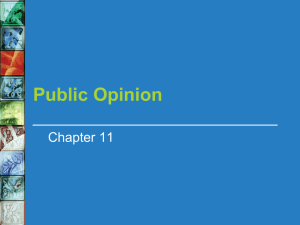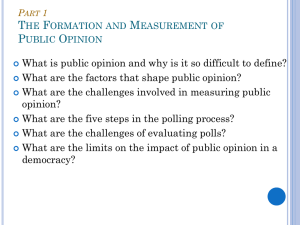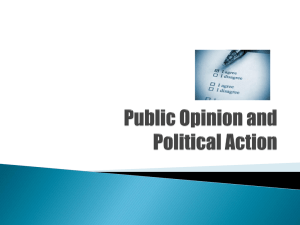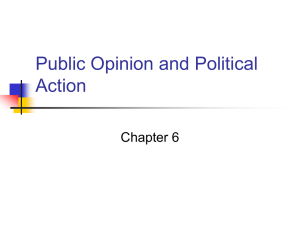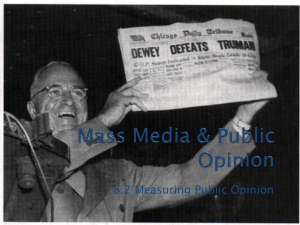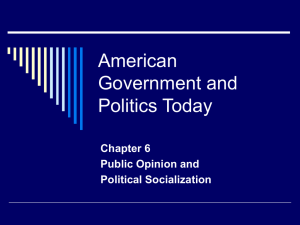Question 6 Exemplar - Education Scotland
advertisement
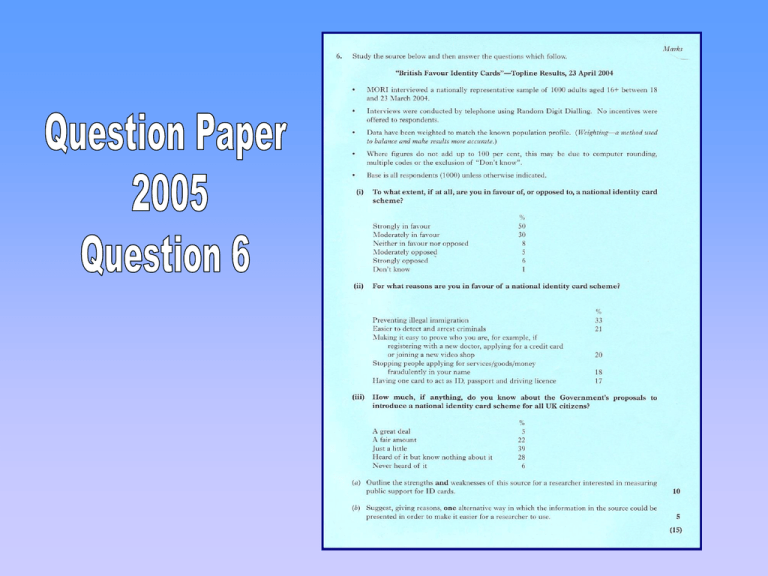
6 (a) Outline the strengths and weaknesses of this source for a researcher interested in measuring public support for ID cards. (10) 6 (b) Suggest, giving reasons, one alternative method by which the information could be presented in order to make it easier for a researcher to use. (5) Outline the strengths and weaknesses of this source for a researcher interested in measuring public support for ID cards. (10) Key word – ‘this source’ – means that you must examine the source of the information very carefully. You should focus on: • the fact that it is an opinion poll • the fact that the opinion poll was carried out by MORI, an internationally respected polling company • how the poll was conducted Outline the strengths and weaknesses of this source for a researcher interested in measuring public support for ID cards. (10) date on which the poll was carried out characteristics of the sample who has been sampled and who has been left out? size of the sample use of ‘weighting’ use of ‘rounding’ type of questions asked Question asks you to describe and explain the strengths and weaknesses of this source of information. Your answer therefore must be balanced for full marks. This means that you must address both the strengths and the weaknesses. If you do not, your answer will be marked out of 6 marks and not 10. Your answer though does not have to be equally balanced. It is possible to achieve 6 marks for strengths and 4 marks for weaknesses or vice versa. You will get a lot of credit for developing your points and for providing exemplification. Answers that simply list points will not receive a high mark. Answers that show a lack of knowledge or understanding of the issue will not achieve high marks. Company used to carry out the opinion poll: MORI is an internationally respected polling company has a lot of experience in carrying out opinion polls; knows importance of sample size, characteristics of sample population etc. and has to stay in business so it has to maintain its credibility as a polling company. has to stay in business so it has to maintain its credibility as a polling company. used by many high profile companies such as market research, newspapers and political parties to gauge public opinion on many issues. is used by many high profile companies such as market research, newspapers and political parties to gauge public opinion on many issues. Company used ‘weighting’ to choose the sample Weighting ensures that the sample of 1000 people aged 18 and over are representative of the whole population of the UK. Weighting takes into account the following characteristics of the UK population: its age structure its gender structure socio-economic structure. Size of sample 1000 Use of computer rounding Many critics of opinion polls wonder how a sample of around 1000 people can be representative of the opinions of millions of people. This will introduce statistical error into the final results reducing their level of accuracy. Research method used – advantages and disadvantages Advantages of telephone interviewing using RDD – Random Digit Dialling. •RDD provides a representative probability sample of all telephone users, unlike telephone surveys which rely on registered telephone number lists or directories. (Telephone interviewing has traditionally been regarded as unreliable because of the difficulty of obtaining an unbiased genuinely random sample from the phone book). • ICM and Gallup argued that 94% of the population could now be contacted by phone. RDD can be used to contact ex-directory numbers. •Good because people who are ex-directory can now be contacted; mainly female, people living on their own – no longer excluded from the sample. Research method used – advantages and disadvantages Advantages of telephone interviewing using RDD – Random Digit Dialling. •Telephone interviewing makes it easier and cheaper to get a wider sample in terms of geographical positioning; avoids clustering which happens with postal surveys. •Allows for more stringent checks to be carried out on those who are interviewing because they are all based in one central position rather than being spread throughout the country. Research method used – advantages and disadvantages Disadvantages of telephone interviewing using RDD – Random Digit Dialling. •10% of the UK population do not have a telephone – these people are also excluded from the survey – mainly people in the lower socioeconomic groups in society. •Still the problem of ‘obtaining a response’- non-contacts and refusals. •Still the problem of reliability of information received over the phone. People find it easier to make false comments on the phone. Is the person on the phone who they say they are? Reliability of opinion polls as a source of information Opinion polls are inherently limited in their value as predictors because they only represent a ‘snap-shot’ of public opinion at the time the survey is carried out and the results ‘go to press’. Opinion polls can only measure what people say. What people say and actually do are often not the same and so if used to predict how people might vote on the issue, opinion polls are not accurate. Reliability of opinion polls as a source of information This poll was carried out between 18 and 23 March 2004 but the results were not published until 23 April 2004. Some of the respondents may well have changed their mind on the issue during that time. Results therefore may not be an accurate reflection of public opinion. Reliability of opinion polls as a source of information 1972, 1992 General Elections - opinion polls carried out during the election campaign came under criticism for high level of inaccuracy. Opinion polls since 1970 have predicted the wrong outcome in 5 out 7 elections. Reliability of opinion polls as a source of information Some people are inclined to give ’politically correct’ answers to questions. This will inevitably increase the chances and size of error in the result. Many critics of opinion polls wonder how a sample of around 1000 people can be representative of the opinions of millions of people. Type of questions asked in the opinion poll •Questions are examples of ‘closed questions’ – they give the respondent a choice of answers from a directed list. Gives standardised answers. Standardised answers make it possible to identify patterns and make comparisons between the different groups of people such as between males and females or between working-class and middle-class. Results can be replicated easily to check for reliability. Same questions can be repeated at a future date in order to make comparisons over time – longitudinal study. Reduces possibility of interviewer bias. Type of questions asked in the opinion poll With closed questions it is difficult for respondents to elaborate or develop their answers in depth. This means that the results may not be wholly valid in that they do not give a true picture of the respondent’s point of view. Difficult to make generalisations or assumptions based on the results. Key words – information, presented, easier, a researcher. Consider how the information is presented by MORI e.g. b) Suggest giving reasons, one alternative way in which the information in the source could be presented in order to make it easier for a researcher to use. •The questions are written in bold. •The standardised answers are listed underneath. •The number who responded to each standardised answer is given beside it in %s. How could this be improved upon? Primary data that is collected in statistical form can be presented in a variety of graphical ways. Presenting data in this way is very important because it helps analysis. helps identify relationships between variables helps identify patterns helps summarise data Graphical representation is important because it makes a report more attractive clarifies text demonstrates points more forcibly There is a huge range of graphical and cartographical techniques available The technique you use will depend on the type of data collected Whatever the technique chosen, it should be neat, colourful and annotated, in order to ensure its impact and effectiveness. So all diagrams must have: a title a key colour a labelled axis and be referred to in the text Results of Opinion Poll on Identity Cards •A comparative bar graph is used to show the frequency or amount of a number of different categories or questions. •The bars are drawn with a gap in between them, and they are coloured or shaded differently. This is because the categories are unconnected. Percentage 100 50 Key Yes No Don’t know 0 1 2 Questions 3 Results of Question (i) To what extent, if at all, are you in favour of, or opposed to, a national identity card scheme? This method of presenting the results is called a histogram – used when results are connected – ‘yes’,‘no’,‘don’t know’ It has the same advantages as for a bar graph however in this example three histograms would have to be drawn: Percentage 100 50 •one for each question •a different colour could be used for each question. 0 Yes No Question (i) Key Percentage Don’t know Results of Opinion Poll on Identity Cards Percentage Question 1 Question 2 Question 3 Key Yes No Don’t know 100 50 It has the same advantages as for the vertical presentation. 0 This is an example of a comparative bar graph on its side. Results of Question (i) To what extent, if at all, are you in favour of, or opposed to, a national identity card scheme? Yes No Don’t know Key Percentage 100 50 It has the same advantages as for the vertical presentation. 0 This is an example of a bar graph on its side. Percentage Question 1 :To what extent, if at all, are you in favour of, or opposed to, a national identity card scheme? 5% Strongly in favour 6% 1% Moderately in favour 8% 50% 30% Neither in favour nor opposed Moderately opposed Strongly opposed Don’t know 5% Strongly in favour 6% 1% Moderately in favour 8% 50% 30% Neither in favour nor opposed Moderately opposed Strongly opposed Don’t know A pie chart is a good way of showing how a whole is divided up – in this case the answers to the question. Each segment of the pie represents the possible answers to the question. The size of a segment represents the percentage support for that answer e.g. ‘Don’t know’ = 1%. The use of different colours for each segment makes it easier to distinguish between the different levels of support for each answer. Question 1 :To what extent, if at all, are you in favour of, or opposed to, a national identity card scheme? 5% Strongly in favour 6% 1% Moderately in favour 8% 50% Neither in favour nor opposed Question 2 : For what reasons are you in favour of a national identity card scheme? Moderately opposed Strongly opposed 30% Don’t know Preventing illegal im m igration 16% 0% 30% Question 3 : How much, if anything, do you know about the Government’s proposals to introduce a national identity card scheme for all UK citizens? Making it easier to prove w ho you are 17% 18% A great deal 6% 6% Easier to detect and arrest crim inals 19% Stopping people applying for goods etc fraudulently in your nam e Having one card to act as ID, passport and driving licence A fair amount 22% 28% Just a little 38% Heard of it but know nothing about it Never heard of it Good way of comparing and analysing the results for all three questions. No marks are given for the choice of alternative method of presentation. Marks are given for the explanation of method chosen e.g. why that method would be easier for a researcher. For full marks you would have to give at least two well developed points.
